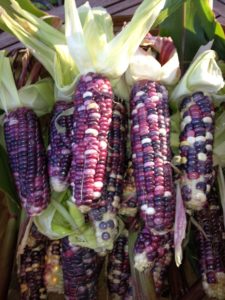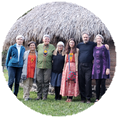On August 25, 2018, at a Fire Speaks event in New Freedom, Pennsylvania, USA, we will request Grandfather Fire to tell us the Sacred Story of Corn. We hope this post intrigues you and inspires you to join us for this unique opportunity. Sacred stories are passed down through the ages to help humans remember timeless wisdom that promotes living in a heart-centered way. Such ancient lessons speak to the danger of allowing ego-mind to lead the way, and highlight the acts of courage and compassion that restore balance, harmony, and joy. Today’s conversations about social, environmental, and political issues would do well to take into consideration the teachings contained in these sacred stories.

Why does Corn matter to humans? Yes, it’s a staple food. It also serves as animal fodder, a fuel alternative and a source of countless industrial by-products used for everything from make-up to wallpaper. Yet for those who take the time to connect with the earth and perhaps even plant their own small patch of corn by hand, Corn has been and remains an important teacher of the steady cycles of time and the meaning of sustainability; of patience and overcoming obstacles; and of the importance of community, dependable relationships, and conscious gratitude.
For the Huichol people of the Mexican Sierra Madres, the relationship to Corn is so intimate that there are separate names for Corn depending on its stage of life. Girls are often given these names according to the timing of their birth.
Huichol Names for Corn (Maize):
Milpa
A corn (maize) field.
Hakarima
A milpa that is putting forth shoots.
Turama
When the first sections on the green cornstalks appear in the milpa.
Niekame
When corn stalks first appear.
Yiurama
Means ‘to grow’; commonly given to girls born when the milpa is growing.
Tsaulima
When the ears of maize are forming.
Xitaima
The stage of growth of maize when the ears first emerge.
Xutuima
The stage of growth of maize when the first hairs appear on the ears of maize.
Kuipaima
Corn silk appearing on the corn.
Xaurima
The growth stage of maize when the ears are tender and ready to be harvested.
’Utsîma
Maize that has been specially reserved and protected. Girls born when the kernels of maize have been removed from the corncob and are stored.
Yuawima
The name for blue corn
Wiyema
Rain—girls born during the rainy season.
Neixa
Time of harvest ceremony.
Our purpose here, however, is to highlight the precious lessons and opportunities that come from developing a personal relationship with Corn (capitalization intentional!) This is a relationship that many members of the international Sacred Fire Community have been fostering because of wisdom shared by two ancestrally related peoples from Mexico—the Huichol and the Nahua. As a result of their remote location in the high Sierra Madres, these peoples were able to avoid early European colonization and to retain their cultural identity and practices, with an unbroken oral history at least 10,000 years old. (Sadly, today communication via Internet and cell phones has brought confusing outside influences that create a struggle for elders trying to keep their traditions intact. Sacred Fire Community’s sister organization, the Sacred Fire Foundation, supports initiatives to preserve this vital ancestral wisdom.)
For the Huichol, the relationship to Corn is so intimate that there are separate names for Corn depending on its stage of life, and children are often given these names according to the timing of their birth. Prescribed rituals and ceremonies accompany planting, tending, and harvesting corn, and are also carried out to benefit the health of human relationships, for example between husband and wife or between members of a village. Many of these rituals include a degree of sacrifice, careful preparation, and focused attention. To some, these practices may seem outdated, superstitious, and overly painstaking. Yet in the face of modern society’s hustle and bustle, there are precious gifts to be had, far greater than mere physical nourishment, when we humans take the time to slow down and spend some time with Corn—and with each other.
Jaime Velez, a Colombian residing in Mexico most of his adult life, puts it this way: “I am Corn. What I mean is, I feel very deeply that Corn is my connection with the Earth. I relate corn’s sweet smell to mother’s milk, to home, to nutrition, to an unconditional generosity that feeds everybody—the rich, the poor, anybody. For me, corn tastes like wind and rain, and it has a special connection to fire also. When you put corn on the fire, it softens and awakens, bringing forth a particular aroma, like perfume.”
Jaime, who is both a Sacred Fire Firekeeper and a mara’akame (traditional healer in the Huichol tradition,) continues: “Corn is a teacher because the plant itself teaches us how to move beyond obstacles. Corn can fall down because of wind and animals, but it can recover its vertical ascent towards the sky. One night, the whole stand of corn may be on the floor, and the next day it can be up again. Moreover, corn has amazing adaptability to different types of terrain and can grow in very harsh landscapes and climates.”
Deanna Jenné began her deep relationship with Corn when she entered the path toward becoming a mara’akame two decades ago. “I was told to keep corn at my altar. It has taught me about community and the interrelationships of all life, and how I am connected to something greater than myself. Corn needs us as we need it, and keeping that relationship alive is important to me. Every year I place new corn stalks on either side of my altar. Recently I was the representative for my fellow mara’akate during an annual prosperity ritual held in Mexico, one that is centered around the growing, caring, and harvesting of corn. Corn can teach us a different way of being, and help center us in a different way of relating to the world.” Deanna goes on to share that her local community also holds seasonal ceremonies to honor the cycle of life, using the beautiful corn grown on the community land for the sacred offerings.
“Planting corn every year is a commitment to a new cycle of life,” Deanna continues. “It has been a particular journey finding the right corn that will grow here where I live, in the high desert of the Grand Mesa in Colorado. We live at 6000 feet. It is dry, with only eight-sixteen inches of rain a year, and the nights are cool even in summer. Plus, there can be strong winds. I have now found the perfect corn: it is a short corn, with a beautiful jewel tone. We save the best of that and replant it every year. I believe that if you have corn, you have everything, and life is abundant.”
Eliot Cowan, author of Plant Spirit Medicine, and a tsaurirrikame (elder mara’akame,) tells a story that captures how the Huichols understand that proper spiritual alignment is part of tending the relationship with Corn. Several years ago he found himself in a Huichol village with a group of mostly Americans. The traditional governor of the village came to Eliot, asking for help. There was a serious drought, with no end in sight, and the precious corn crop was in danger of being lost. For the local people, there would be no government help, and there was very little in the way of money to buy any form of replacement food.
The villagers wanted to go to a nearby sacred site and make offerings to pray for beneficial weather, but they didn’t even have the money to buy the necessary offerings. Eliot’s group took up a collection to buy what was needed, and the villagers immediately took off to perform the traditional ceremony. The very next day it rained. The corn crop was successful, and the people had what they needed for one more year.
Eliot and his wife Vicky were married in 2015 and now live in upstate New York, in Mohawk territory. As part of preparing for their marriage, in order to benefit their own union and their community, they were asked to grow Huichol, Nahua, and Mohawk corn. This year, the Ancestors of the Land where they live have guided them to plant only Mohawk corn. The men and women of the community do the harvesting in a highly ritualized way. “There is a four-day preparation toward that harvest and one aspect is a kind of a giveaway—something the Mohawk apparently did a great deal of, giving away some of their most important possessions to other people in the community. This is a way of reconnecting to the generosity that Nature and Corn demonstrates, and we do that as well.”
Jane Wollack, who lives in western North Carolina, USA, shares that she has been a gardener most of her life, but when she started growing corn in earnest, she became aware that it is “not just an everyday plant. I have a very intimate relationship with Corn, as She comes up and grows. I spend a fair amount of time in my cornfield, listening to the wind rustling, watching corn’s journey from infancy to adolescence to motherhood to elderhood and finally to its release through death, all in a single growing season. It is a magical experience for me.”
“One of my biggest teachings as a tender of the corn garden is that I have ultimately no control over what happens. Some years are incredibly bountiful, some not. Every new place I live, I have to start fresh. It sometimes takes a number of years for the garden to become productive, more or less depending on whether the soil has been mistreated. So, I have to be patient in rebuilding the soil. As I come from a place of deep love, Corn has taught me a great deal about patience and a real respect for the process of growth and maturation, the cycle of just living, and how precious that is. It has taught me that there is absolutely nothing wrong with doing the same thing every year, growing the corn the same way every year. There are always variations. Naturally, weather has an effect. Overall, I have learned to respect, enjoy and cherish this rhythm of life and of growing things.”
Linda Felch and Randy Whitlock grow a wide variety of corn on their land in New Freedom, PA, USA. Linda, a Sacred Fire Firekeeper, reminisces: “We moved here from the city almost fifteen years ago. I noticed within a year that we were eating a lot of corn—grits, corn on the cob, tortillas, and popcorn. So I decided to try to grow corn, first popcorn and several varieties of sweet corn, and then other corns from Mexico, big ones to grind for flour and smaller ones for grits. In Mexico, we also learned how to process the corn to make it more digestible and produce less blood sugar fluctuations, which is great for Randy, who is a diabetic. It’s called nixtamalization, and involves soaking and cooking the corn in an alkaline solution, usually limewater. This brings out the proteins and B vitamins and decreases the carbohydrates. In all the Mesoamerican cultures, how to do this process is part of their sacred stories. To ‘have nixtamal’ means you are taken care of, you are nourished.”
Randy echoes how this community aspect of corn has become clearer to him during his time in the Huichol homelands, which he and Linda frequently visit as part of their commitment as mara’akate. “It took a community to grow corn as an indigenous group. People would live in the cornfields so the raccoons would not ruin their corn. It gives me a whole other view of how community can work together—to nourish us, to nourish life. As a result of some childhood trauma, I find that a big healthy family is really important to me, so when I looked into a Huichol kitchen and saw girls and women ages ten to seventy, working and laughing together, grinding corn and making tortillas, it totally drew me in. Even though everyone made fun of me, because in that community the kitchen work is considered women’s work, I got permission to watch and learn. Unfortunately, even though I dragged home a metate, a heavy grinding stone, I still can’t replicate their perfect tortillas!”
 Closer to home, Randy had another very powerful experience with corn. With a background in archeology, Randy has a particular interest in the peoples native to where he lives, the Susquehannocks. Last year, the couple found locally sourced heirloom corn seeds called Tutelo. After putting a lot of effort in hand tilling and fertilizing the soil, he began to plant the seeds. And then something unexpected happened. “When I started to actually plant the seeds, I kept seeing these ancestors—mainly just their faces. They were definitely native people. So I continued to plant, and I became so overwhelmed with grief that I could not continue. It felt like this enormous storm that was just pounding me with rain—this incredible, really deep-seated grief. Linda came over and was trying to find out what the heck was going on I said, ‘Well, I’m just letting it happen.’ After ten to fifteen minutes, it felt like the storm sort of passed. I had some seeds clutched in my hands. When I opened my hand and looked at the seeds, I became aware that they were the color of the skin of the people. Not just a corn seed, but the color of the earth, like orange-pinkish colored soil. It just made the experience very vivid and rich and it came to me very clearly that there was a tremendous amount of unexpressed grief still held in the land here.” Later I shared this story with an Iroquois woman. She knew that particular corn from her reservation, the name of it. She said to me ‘Well, you know, the Mother came right through you and you helped to express something that she needed to express.’ I was so grateful that I could share that with someone who already had that in her heart. I now have a much broader experience of corn, of Mother Corn, as a goddess.”
Closer to home, Randy had another very powerful experience with corn. With a background in archeology, Randy has a particular interest in the peoples native to where he lives, the Susquehannocks. Last year, the couple found locally sourced heirloom corn seeds called Tutelo. After putting a lot of effort in hand tilling and fertilizing the soil, he began to plant the seeds. And then something unexpected happened. “When I started to actually plant the seeds, I kept seeing these ancestors—mainly just their faces. They were definitely native people. So I continued to plant, and I became so overwhelmed with grief that I could not continue. It felt like this enormous storm that was just pounding me with rain—this incredible, really deep-seated grief. Linda came over and was trying to find out what the heck was going on I said, ‘Well, I’m just letting it happen.’ After ten to fifteen minutes, it felt like the storm sort of passed. I had some seeds clutched in my hands. When I opened my hand and looked at the seeds, I became aware that they were the color of the skin of the people. Not just a corn seed, but the color of the earth, like orange-pinkish colored soil. It just made the experience very vivid and rich and it came to me very clearly that there was a tremendous amount of unexpressed grief still held in the land here.” Later I shared this story with an Iroquois woman. She knew that particular corn from her reservation, the name of it. She said to me ‘Well, you know, the Mother came right through you and you helped to express something that she needed to express.’ I was so grateful that I could share that with someone who already had that in her heart. I now have a much broader experience of corn, of Mother Corn, as a goddess.”
The next time you find yourself enjoying a dish made of corn, consider the gifts of the Earth. Today, when most of us forage in the grocery store aisles and not out in Nature, and when we may cultivate our physical appetites far more than our relationship to the Source of our sustenance, allow these stories of Corn to remind you to take time for gratitude—for what nourishes you, for the relationships that support you, for Life itself.
For more information on the August Fire Speaks where we will request Grandfather Fire to tell us the sacred story of corn, click here.












